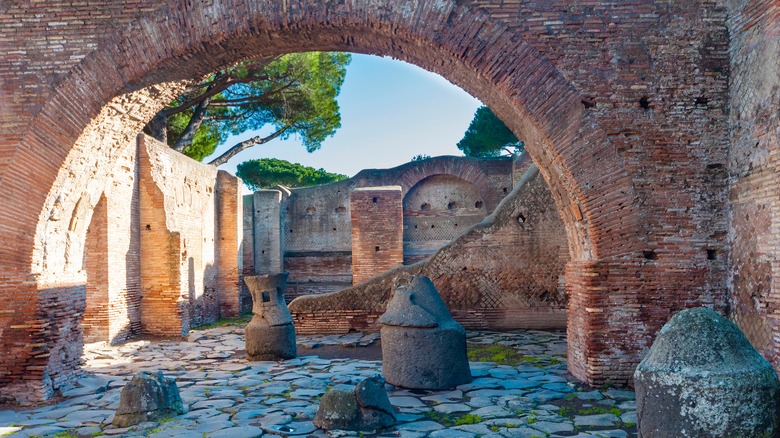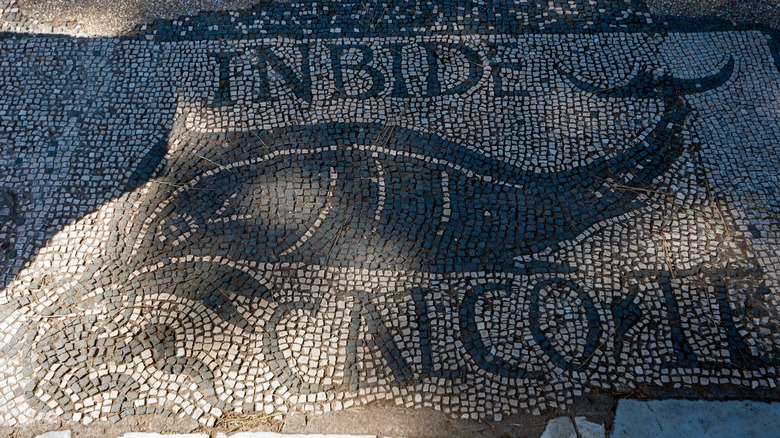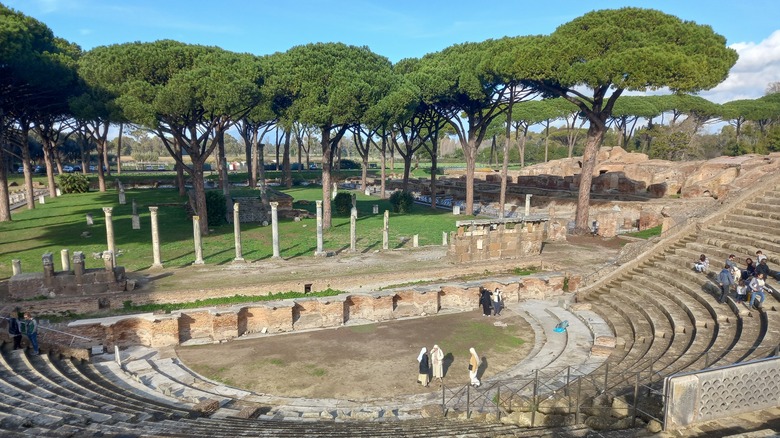This Ancient Port City Right By Rome Is A Less Chaotic And Uncrowded Alternative To Pompeii
If you're visiting Italy, it's a pretty good bet that you're starting your vacation in Rome. That means, if you want to visit the ancient ruins of Pompeii, you're looking at traveling around 150 miles away from where you began. That can cost you a lot of time, a new hotel or rental in a different city, and fewer hours to actually see the sights. Pompeii is wonderful, of course. In fact, it got almost 3 million visitors in 2022. However, you can find a less crowded ancient city much closer to Rome in Ostia Antica. Just around a 30-minute drive from the Eternal City, Ostia Antica is a lesser-known but incredible spot to see ancient ruins, much like the Appian Way just outside of Rome is.
One Reddit user posted about Ostia Antica, saying, "Love Ostia, spent the entire day there and still wanted to go back the next day. Enjoyed it way more than Pompeii. Less crowded and easy to get to." Another said, "Absolutely, probably my favourite place of all time. Four hours there wasn't enough, I could spend days. There were so few people too, especially off the main road, felt like I had it all to myself." Even travel pro Rick Steves says Ostia Antica has "ancient thrills to rival Pompeii." There are the ruins of Roman baths, snack shops, an amphitheater which still puts on performances, and so much more in this incredible ancient port city.
What to know about Ostia Antica's history
"Ostia" means the mouth of a river and the ancient port city was indeed at the mouth of the river Tiber (which has changed its course over the years). According to legend, Ancus Marcius, one of the kings of Rome (before the Republic, which was, in turn, before the Empire) founded Ostia Antica in 620 BCE, however the earliest ruins are from the 4th century BCE. It was once a place to harvest salt, a military camp, and a center for trade and business. However, as the Roman Empire got bigger, Ostia Antica lost importance. These days, there are extensive ruins to see, as well as a museum with artifacts.
While the first Sunday of each month is free, tickets to Ostia Antica are around $19.50 the rest of the week, with EU residents between 18 and 25 paying just $2. You can also purchase short or long tour audio guides. You'll find a cafeteria and snack machines to grab a bite. You may be surprised to learn that you can bring your leashed dog to the site. However, you cannot use drones as Ostia Antica is close to Rome's Fiumicino Airport.
One fascinating feature is the ancient amphitheater, which holds up to 3,000 people, and is still used for concerts and other performances. You can really get a sense of what Ostia Antica was like for the average person in a building called the House of Diana. It's several stories high, with the ground floor once used for shops, and apartments above.
Places to visit in Ostia Antica
As you walk through the archeological park, you can see how the older buildings are lower in the ground than the higher ones. (Splurge on some good walking shoes as the paths can be uneven.) One spot of interest is the Square of Guilds, which had mosaics on the ground that indicated what each area was for, like a fish (middle pic) for a fish merchant, or an elephant mosaic to indicate traders from Africa. Then there is the Capitolium in the Ostia Forum, a temple dedicated to the gods Juno, Jupiter, and Minerva. There are a number of public and private baths like the Baths of Neptune, which had mosaics, cold and warm pools and saunas, massage rooms, and an open-air palestra where people exercised.
You have to check out the Thermopolium, which was kind of like a snack shop (a feature Pompeii has in common with Ostia Antica) with a still-existing counter, and frescoes of what you could order to eat on the walls above. There is the necropolis at the entrance with tombs and mosaics, and banquet tables for the living to feast at to celebrate those who had passed. You can even see what the public toilets were like. There are three walls with benches running around them, with around 20 seats side by side with no dividers between them. If it doesn't make you appreciate our modern conveniences, nothing will.


